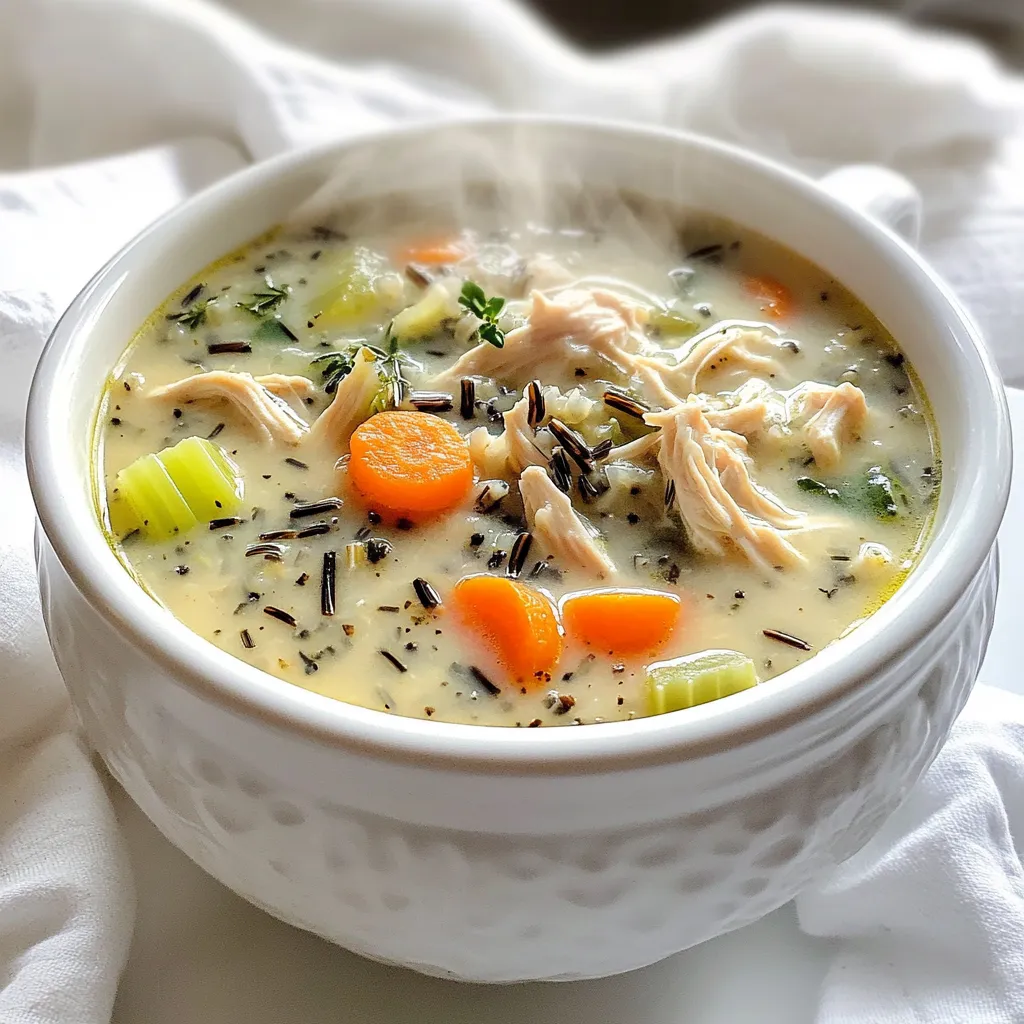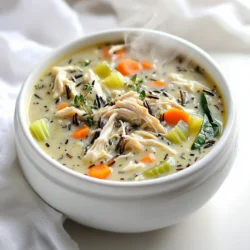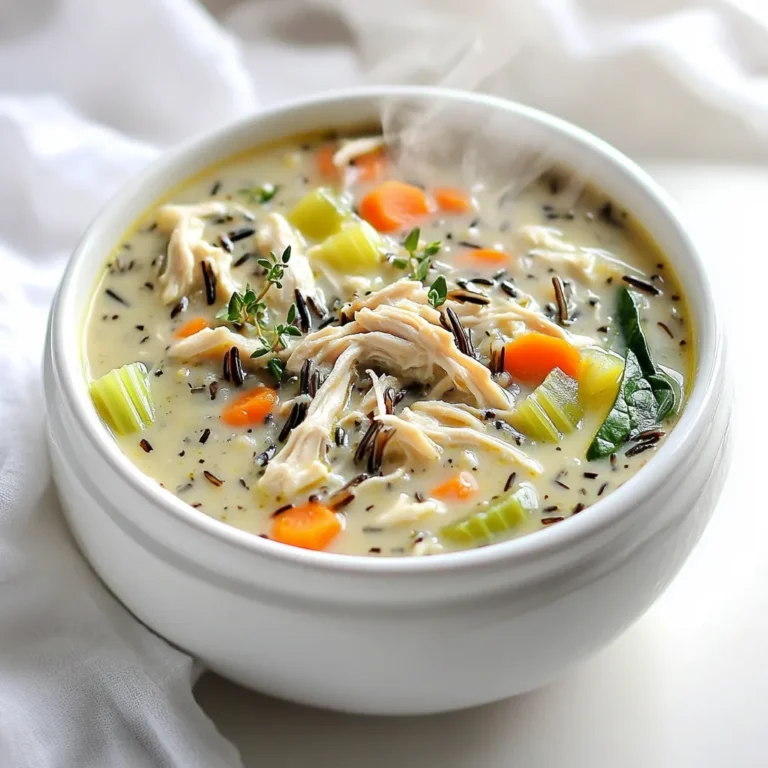Are you ready to elevate your Slow Cooker Chicken & Wild Rice Soup? In this guide, I’ll share how to boost the flavor of this cozy dish! I’ll cover essential ingredients, cooking tips, and creative variations. From choosing the right veggies to adding herbs that pop, you’ll learn everything you need for a delicious meal. Let’s turn your ordinary soup into a flavor-packed delight you’ll want to make again and again!
Ingredients
Main Ingredients Needed
For this cozy soup, you’ll need:
- 1 pound boneless, skinless chicken breasts
- 1 cup wild rice, rinsed
- 1 medium onion, diced
- 2 carrots, diced
- 2 celery stalks, diced
- 3 cloves garlic, minced
- 6 cups chicken broth (low sodium)
- 1 cup cream (or coconut cream for dairy-free)
- 1 teaspoon dried thyme
- 1 teaspoon dried rosemary
- Salt and pepper to taste
- 2 cups fresh spinach (or kale), chopped
- 2 tablespoons olive oil
These ingredients come together to create a warm and filling meal.
Optional Ingredients for Flavor Enhancement
To take your soup to the next level, consider adding:
- Fresh herbs like parsley or dill for a bright touch
- A splash of lemon juice for a zingy flavor
- A pinch of red pepper flakes for heat
- Mushrooms for earthy notes
- Corn for sweetness and texture
These extras can really make your soup shine and add layers of flavor.
Suggested Substitutes for Dietary Needs
If you need to adjust for dietary needs, try these options:
- Use turkey instead of chicken for a leaner protein.
- Swap wild rice for brown rice or quinoa if preferred.
- Use vegetable broth instead of chicken broth for a vegetarian option.
- Coconut cream is a great dairy-free choice for cream.
These substitutes ensure everyone can enjoy this delicious soup without worry.
Step-by-Step Instructions
Preparation of Vegetables
Start by gathering the vegetables. You will need one medium onion, two carrots, and two celery stalks. Dice them into small pieces. This helps them cook evenly. Heat two tablespoons of olive oil in a large skillet over medium heat. Add the diced onion, carrots, and celery. Cook for about five minutes until they soften. Then, add three minced cloves of garlic and cook for one to two more minutes. This step builds a great base for flavor.
Slow Cooker Layering Process
Now, let’s move to the slow cooker. Place one pound of boneless, skinless chicken breasts at the bottom. This keeps the chicken moist. Next, add the sautéed vegetables right on top of the chicken. Then, pour in one cup of rinsed wild rice. Follow this with one teaspoon of dried thyme and one teaspoon of dried rosemary. These herbs add a lovely scent and taste. Finally, pour in six cups of low-sodium chicken broth, making sure everything is covered. Taste and sprinkle in salt and pepper to your liking.
Cooking Times and Techniques
Cover the slow cooker and set it to cook. You can choose low for six to seven hours or high for three to four hours. The chicken should shred easily, and the rice should be tender when done. Once cooked, use two forks to shred the chicken directly in the slow cooker. Stir in one cup of cream or coconut cream and two cups of chopped fresh spinach. Let it simmer for an extra ten to fifteen minutes. This step wilts the spinach and makes the soup creamy and delicious. Adjust seasoning to taste, and it’s ready to enjoy!
Tips & Tricks
How to Ensure Perfectly Cooked Chicken
To keep your chicken moist, choose boneless, skinless breasts. This cut cooks evenly and stays tender. When you start cooking, place the chicken at the bottom of the slow cooker. This helps it soak up all the broth’s flavor. Cook on low for 6-7 hours or high for 3-4 hours. Always check for doneness by shredding the chicken with forks. If it pulls apart easily, it’s perfect.
Best Practices for Wild Rice Cooking
Wild rice takes longer to cook than white rice. Rinse it well before adding it to the slow cooker. This removes excess starch and helps prevent clumping. Add the wild rice along with the other ingredients. Stir it in to ensure even cooking. The wild rice should be tender but still have a slight chew when done. If it’s undercooked, let it simmer a bit longer with the lid on.
Enhancing Flavor with Herbs and Spices
Using dried thyme and rosemary gives your soup a cozy, earthy flavor. Feel free to adjust the amounts to your taste. If you want more depth, consider adding bay leaves or a pinch of nutmeg. Fresh herbs like parsley or dill can brighten the soup when you serve it. A squeeze of lemon juice at the end adds a nice twist. Always taste your soup before serving. Adjust salt and pepper as needed for a balanced flavor.

Variations
Dairy-Free Alternatives
You can swap cream for coconut cream. This keeps the soup rich and creamy. Coconut cream adds a hint of sweetness, too. If you want a lighter option, use almond milk. You can also try cashew cream for a nutty flavor.
Adding Extra Vegetables
Feel free to load this soup with more veggies. Add zucchini, bell peppers, or mushrooms for depth. Sweet corn gives a nice pop of color and sweetness. Try adding green beans or peas for extra crunch. The more veggies, the better the soup!
Different Protein Options
Chicken isn’t the only choice. You can use turkey for a twist. Shredded rotisserie chicken saves time and adds flavor. If you want a vegetarian version, use chickpeas or lentils. These options make the soup hearty and filling.
Storage Info
How to Store Leftovers
After enjoying your soup, let it cool down. Pour the soup into an airtight container. Seal it tight and store it in the fridge. It stays fresh for about 3 to 4 days. If you plan to eat it later, move on to freezing.
Reheating Instructions
To reheat, take the soup out of the fridge. You can warm it on the stove or in the microwave. If using the stove, heat it gently over low heat. Stir often so it warms evenly. In the microwave, heat in short bursts of 1 to 2 minutes, stirring in between. Always check the temperature before serving.
Freezing Tips for Long-Term Storage
For long-term storage, freezing is the best option. Pour the cooled soup into freezer-safe bags. Remove as much air as you can before sealing. Write the date on the bag. You can freeze it for up to 3 months. When you want to eat it, thaw it overnight in the fridge. Then, reheat as mentioned above.
FAQs
Can I use brown rice instead of wild rice?
Yes, you can use brown rice. However, it cooks differently than wild rice. Brown rice takes longer to cook. You may need to add extra broth and extend the cooking time. I recommend cooking brown rice separately and adding it at the end. This way, it stays tender and absorbs the soup’s flavors well.
How long can I store leftover chicken soup?
You can store leftover soup for up to four days in the fridge. Make sure to keep it in an airtight container. If you want to keep it longer, freeze it. It will last up to three months in the freezer. Just let it cool before freezing. When you’re ready, thaw it overnight in the fridge.
What can I serve with Slow Cooker Chicken & Wild Rice Soup?
This soup pairs well with many sides. Here are some great options:
- Crusty bread or rolls
- A fresh green salad
- Crackers or breadsticks
- Roasted vegetables
Each choice adds a nice touch to your meal. Enjoy mixing and matching!
This article covered how to make Slow Cooker Chicken & Wild Rice Soup. We discussed the main and optional ingredients, as well as helpful substitutes. I shared step-by-step instructions for preparation and cooking, along with tips for cooking chicken and wild rice perfectly. We also explored variations and storage info for leftovers.
This soup is easy to make and full of flavor. You can adapt it to fit your needs and keep it fresh in your fridge or freezer. Enjoy making this delicious meal!



